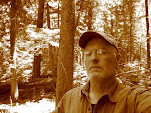I once heard about how racing sled dogs are trained. When they are pups, they are taken out for runs on twisting and turning roads and trails. The dogs become motivated by curiosity...always pushing to see what is around the next bend. In fact, when people have used dogs to cross very large icefields, they often have to send someone out a few hundred yards...a moving dark figure to the dogs, something to hold the dog's attention, something to draw them forward.
 |
| After the second bend |
I put in at the Foote Bridge on the East River. This is usually a turn-around point, but there is a high high tide coming today and the place I use near the sea will be flooded with several inches of seawater. I'll turn back at the sea.
 |
| After the third bend |
It sprinkles lightly as I start. It is what the day is...a bit warm for this time of year, with a sure prediction of drizzle, rain, fog, or all of the three. The wind is out of the east, which is only normal when a patch of strong weather is coming from the west.
 |
| After the fourth bend |
I photograph the view as I round each bend. When I am on a river for the first time and the day is getting long and I'm thinking of returning, it is always, "one more bend, one more bend," until it just can't be "one more bend." At about half of the bends, I flush a few black ducks, never getting close enough to bother with a photograph.
 |
| After another dozen bends or so |
The Sneak is brimful and wide with the flood current changing and going in my direction. The Sneak is all bends, I slip the camera into the top of my life vest and leave it there. At Bailey Creek, I turn upstream for the first time and it begins to rain for real. The camera goes into its waterproof box.
The creek is full to the tops of the banks and I follow it to where it disappears...a submerged culvert under a road instead of a bridge to pass through. It was new to me, it was all bends.
 |
| The Sneak |
It continues to rain as I head down and into the Neck River, and the wind carries the rain with just a little malice as I head down to where the Neck and East meet. I see a large animal head swimming my way...I have no idea what it could be, so odd, and caught addled, the camera stays packed. It is a skate, a foot across, swimming on the surface of the water. It skims the side of the canoe as we pass.
I return up the main channel of the East, riding the last hour of the flood current until it goes slack somewhere before the stone arch bridge. And, it continues to rain a rain that one would not have started a canoe trip in, a rain that would not cut a trip short.



















































